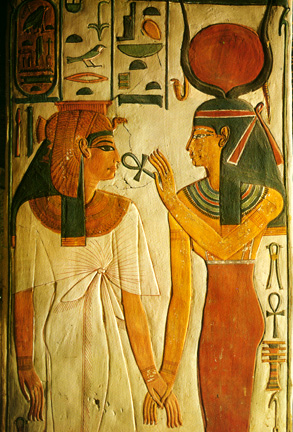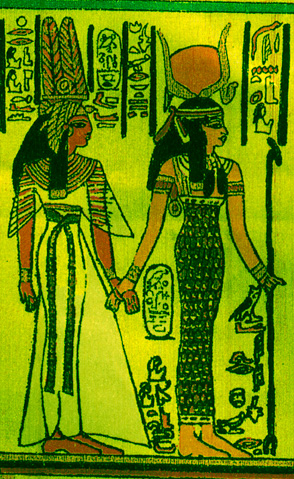Nefertari’s Tomb: The Final Chamber
Boogie Down
To accompany Nefertari, Isis wears a topless dress too, similar to Hathor’s and Neith’s shown on earlier parts of this Tour. Isis’ dress and headdress and headband seem at first glance almost identical to Hathor’s, but Isis’s necklace is not the same, and her dress is edged differently if you look closely. It’s important for each deity to have her own style—and her own accessories!
According to Hans Goedicke (52), hieroglyphs nearby identify this figure as Isis, not Hathor. Since both women are both associated with life and laughter it is appropriate that they are almost twins.
Goedicke claims that the style of dress worn by Hathor and Isis was “fashionable a millennium earlier” than when Nefertari lived (51)—in other words, four thousand years ago. (How does he know? Did he uncover an Egyptian Vogue?) If he is right, then the goddesses are portrayed as if they are descended from an earlier stage of Egyptian civilization—as if time-bound humans can best imagine the age of their deities only by imagining them wearing long-ago fashions. But the fact that such dresses could be so accurately “placed” in time—that is, recognized not as from an earlier decade or even century, but from an earlier millennium—shows the powerful sense of continuity and duration in the Egyptians’ sense of time.
Do Hathor’s and Isis’s and Neith’s dresses really look four thousand years old? What’s odd to a contemporary (Web) viewer without detailed knowledge of Egyptian dynasties or fashions is that such an “old” dress seems radically fresh, timeless as sex itself—and elegance itself. Can you imagine what it would be like to wear one of these topless items on a dance floor?
To be eternal, these ancient painters knew, you also had to be unforgettably stylish.
Isis and the Breath of Life
In the picture above, Nefertari is not topless; she wears a light shoulder-wrap. (The proper modesty of the newly dead? The right dress to wear when traveling? Or is she wearing it and the wrap to keep warm, because it takes her body longer to adjust to the cool air of eternity?) Look at the suave knot- and fold-lines of Nefertari’s white shoulder-wrap above: it is as if these lines are streaming from her sternum or heart.
As Nefertari is about to step across into the world of the dead, she and Isis hold hands, intertwining thumbs. At Nefertari’s mouth and nostrils Isis places an ankh, the hieroglyph of breath, life, spirit. It does not seem to mark the last breath leaving the body when a person dies. Rather, it marks the gift of immortality. Nefertari does not expire or exhale, but inhales.
Yet Nefertari could not receive this gift without another handy accessory: the artist’s (invisible) brush. It too is the ankh of life, in its own modest way.
Underground Stars
In the end, turn your gaze upwards, toward the ceiling of Nefertari’s underground chamber. To see a blue field full of stars…. They are not arrayed to imitate the constellations, but in rows multiplying horizontal and vertical patterns from wall to wall of the tomb. As if what is depicted is not the literal sky but endless permutation itself, infinity.
Close-up, we can see the precise (and precisely different) brush-strokes that make up individual stars. Think about it: the variations in the painter’s gestures—the pressure of hand and brush on the ceiling-surface during a single moment many millennia ago—are just about as infinite as the stars themselves. All made by a long-dead painter or painters as they went about their mortal, immortal labor.
These stars sent out their invisible light in the darkness for thousands of years. Only in 1904 did their light reach us. They are in the dark again now, for their own protection. Yet as they recede from us they also shine here, glowing with the time-shift of virtual light.
From Virtual Tomb to Wrapping Paper
For more information and images of Nefertari’s/Nofretari’s tomb online, see this link.
Images from Nefertari’s tomb and other burial sites now circulate not just on the Web or in expensive library books in the Egyptology section, but also on commercial gift-wrapping paper. There are also many Nefertari tomb images reproduced on fake plaster wall-chunks for sale on the Internet.
To the right is an image from a piece of wrapping paper I received on a recent birthday, reproduced somewhat larger than “life size” here.
It obviously is inspired by one of the tomb’s most famous images, Isis leading Nefertari to the afterlife. The commercial image even copies the women’s hand-holding pose and their slight skin-color difference, though many other details are changed.
Note how in this version the women’s full lips are carefully emphasized.
From a queen bearing gifts to the goddesses and gods of life and death, to our own version of gift-giving many centuries later….
Actual tomb and actual wrapping paper: both sets of images (not to mention meanings) are hard to keep in focus.
The tomb images were not meant to circle the world. After the workers were done and the Queen laid to rest, the torches were taken away. The images of Nefertari’s tomb were to reside underground, in absolute darkness, to be seen only by the eyes of the immortal.
The other set of images, on commercial wrapping paper, is in a way equally invisible, but for a different reason. It is glanced at only briefly until torn open and cast aside, to get at what we think is the real gift.
Surprise, surprise.
Inhale this Tour’s final ankh: how much changes, how much remains the same.
FURTHER TRAVEL:
Primary Source
Goedicke, Hans. Nofretari: A Documentation of Her Tomb and Its Decoration. Graz, Austria: Akademische Druck, Univ. Verlagsanstalt, 1971. Introduction by Gertrud Thausing. Photography by Ekkehart Ritter, March 1963. [Out of print. This is the text cited “Goedicke” in the Tour, and the source of many of the images.]
Other Sources
• McDonald, John K. House of Eternity: The Tomb of Nefertari. Los Angeles: Getty Trust, 1996.
• Angeletti, Roberta. A Journey Throught Time: Nefertari, Princess of Egypt. New York: Oxford University Press, 1999. A children’s book: Anna follows a cat into the tomb of Nefertari, who tells the girl all about Egyptian gods and goddesses.
• OsirisNet. “Tombs of Ancient Egypt: Queen Nefertari.” https://www.osirisnet.net/tombes/pharaons/nefertari/e_nefertari_05.htm




